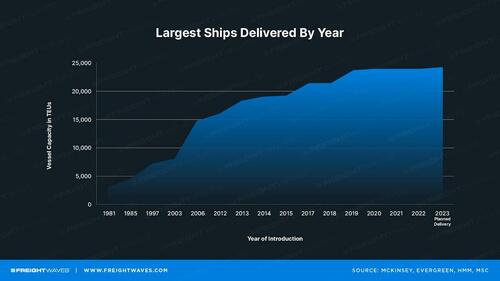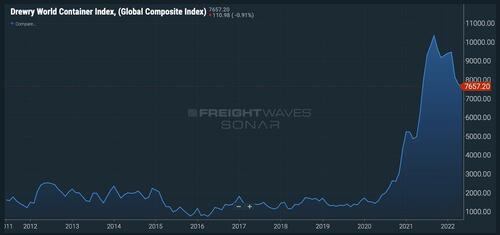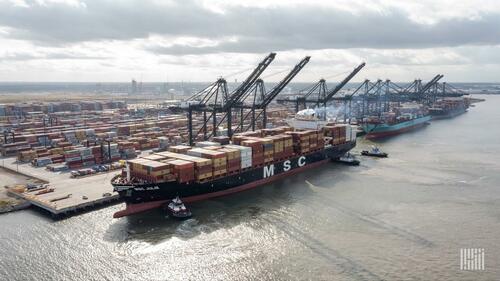Giant Container Ships Are Ruining Everything
By Rachel Premack of FreightWaves
I hate big boats, and so should you...
In 2006, Maersk stunned the global shipping community with the introduction of Emma Maersk, a container ship that could carry nearly 15,000 twenty-foot equivalent units. (TEUs translate to about half of a standard forty-foot shipping container.)
Emma Maersk set off an “arms race” with its introduction. Ocean carriers ordered bigger and bigger ships, believing that they could reach economies of scale if they could jam all their shipments into one big boat instead of a few small ones.
Today, we’ve appeared to reach peak Big Boat Era. The Emma Maersk is now wimpy next to 2022’s true megaships. The largest container ships to be delivered this year have a maximum capacity of 24,000 TEUs. (This class of ship is named — I am not making this up — the “Ever Alot.” The Evergreen shipping company, the very same that blocked the Suez Canal last year, ordered the record-breaking ship.)
Each year brings a new, larger-than-ever megaship. The largest ship class of a given year has increased by 50% from 2012 to today, or nearly sixfold from 1981 to today.

Massive container ships have helped wreak serious chaos on global trade. I spoke with four experts this week to learn how megaships are the sneaky reason for much of our ongoing shipping crisis.
Here are the three reasons I hate big boats:
1. They underpin the global shipping oligopoly.
Global shipping is dominated by a few giant firms. But it wasn’t always this way.
In the 1970s, there were so many ocean carriers that no single company controlled the industry. Since then, the market has consolidated into just a few large firms.
Up to 60 of the 100 largest ocean carriers have vanished from the 2000s to today, thanks to a wave of bankruptcies and acquisitions. The top 10 largest ocean carriers in 2000 commanded 51% of the market; today, they dominate 80% of it, according to a White House fact sheet. All of these companies are based outside the U.S.
Smaller ocean carriers began forming alliances with each other in order to compete with larger carriers, said Campbell University professor Sal Mercogliano. Megashippers decided to copy the strategy. Today, the largest ocean carriers are organized into three major container shipping alliances: 2M, The Alliance and Ocean Alliance.
To ship something from, say, China to Los Angeles, you book space on a container ship operated by one of these alliances. Each company shares space on the container ship with other members of the alliance. But these alliances may cancel — or have “blank sailings” — if demand has slumped.
This system has been great for the carriers’ own financial performance. Some claim this consolidation and the alliance system lead to inflated rates.
The Loadstar, a global logistics publication, reported on April 22 that the 2M alliance was blanking at least three Asia-North Europe sailings. New Chinese COVID lockdowns were one reason for the cancellation, but Loadstar also pointed to 2M’s desire to “halt the slide in rates” amid a slump in volume from China. More canceled sailings mean less capacity for cargo, and likely higher rates.

Container ships have been steadily increasing in size since they were created in 1956. But it wasn’t until the 2000s that the Big Boat Era truly began, Mercogliano said. Ocean carriers believed they could reach economies of scale if they built giant ships. The idea was to put all of your cargo on one massive ship instead of two or three smaller ones.
Such megaships were expensive. Emma Maersk, for example, cost an estimated $145 million. But banks were happy to provide the cash, said Capt. John Konrad, CEO of maritime website gCaptain.
Konrad told FreightWaves that ocean carriers are ideal lending targets. If an ocean carrier defaults on its loan, you can simply repossess any of its ships. And, conveniently, many receive hefty subsidies or other support from the governments of the countries they’re based in. Before the financial crisis, banks were happy to provide massive loans to ocean liners to build the megaships of their dreams.
Then 2008 happened. As Mercogliano said, “The freight dried up.”
Big ocean liners were stuck with massive ships and not much to put on them. Many went bankrupt, and the ones that remained formed alliances.
“Firms started to say, ‘Well, these ships are tremendous investments and there’s too much money on the line,’” said University of Vermont professor Richard Sicotte. “‘Let’s share the capacity among different companies, who would ostensibly be our rivals.’”
Through the 2010s, consolidation accelerated. Eight large carriers, including No. 6 largest ocean carrier Hanjin, either went bankrupt or were acquired by other large firms.
The ‘cartel’ no one noticed?
Crucially, this lack of competition didn’t bother anyone through the 2010s, when ocean rates were absurdly low and carriers were barely turning a profit (if at all). Alliances and consolidation were the only way to make the economics work. Bizarrely, companies continued to build even larger megaships, still chasing those economies of scale while sinking them further into debt.
“Because so few of them were left, they formed these alliances to stop underbidding each other,” Mercogliano said. “The U.S., EU, China, everyone signed off on the idea that these are not cartels. They are not trusts. The reason we did it is because we all benefited from it: We love cheap freight. It cost nothing to move goods across the Pacific.”
That all changed in 2021, when carriers were raking in cash.
The Biden administration called these shipping companies a “cartel.” Some importers have recently claimed that ocean carriers have price gouged them and failed to fill their contracts amid sky-high ocean rates. On the other hand, FreightWaves’ own Greg Miller recently argued that competition among ocean liners increased as rates spiked.
Whether or not these carriers are price fixing is hardly something we can settle in today’s newsletter, but what we can agree on is that this consolidation — driven by the inability of individual companies to fill their own megaships — probably wouldn’t be so stark without those big darn ships.
2. They cause port congestion.
The more obvious reason that big ships are helping cause our ongoing supply chain chaos is that they’re literally too big to fit into most ports. Even the Suez Canal struggled to accommodate one of these megaships, causing the crucial global conduit to be clogged for days last year.
Matt Stoller, who is the director of research at the American Economic Liberties Project, told FreightWaves these megaships are great for moving lots of cargo across oceans. The problem is once you get to your destination. Ocean carriers (and the financial institutions that bankroll them) aren’t paying for updated ports, increased dredging, new warehouses, highways and so on to accommodate these ships. That cost is getting off-loaded to the public, Stoller said.
Indeed, as Mercogliano pointed out, the Port Authority of New York and New Jersey spent a whopping $1.7 billion to raise its Bayonne Bridge to accommodate the shipping scions’ new megaships — a cost that was paid by taxpayers, not ocean carriers or shippers.

One complex is remarkably adept at accommodating those ships: the ports of Long Beach and Los Angeles. As a result, it claims 40% of all U.S. seaborne imports. Before the U.S. saw historic imports in 2020 and onward, this system worked well enough. But over the past year, it’s been remarkably backed up, causing unprecedented supply chain crunches as importers struggled to offload their containers and load empty ones back on to make the trip back to Asia.
If these ships were not so giant, we likely wouldn’t see this kind of congestion. Ocean carriers could bring their normal-sized ships to other ports around the U.S. Stoller pushed for more competition among ocean carriers, which would perhaps mean more diverse types of ships.
“We have a lot of ports in this country but we don’t have enough ocean carrier firms,” Stoller said. “The ocean carrier firms’ boats are too big for most ports.”
3. They’re quietly the reason for the ocean carriers’ financial struggles.
By engaging in the megaships “arms race,” ocean carriers really just played themselves.
One 2016 study by business advisory firm AlixPartners pointed out “the irony of megaships.” In 2016 and 2017, global ocean carrier capacity increased by 4.5% and 5.6%, respectively. But demand only upticked by 1% to 3% those years. The panic to build bigger and bigger ships resulted in depressed rates:
Ironically, says the study, the resulting overcapacity — and corresponding negative effect on profits — is in part the result of the industry’s drive in recent years to correct its chronic supply-and-demand imbalance by building these more efficient but mammoth ships.
Months after that report, the No. 6 largest container shipping company went bankrupt. Hanjin, which had ordered more and more megaships before its insolvency, was in $10.5 billion of debt.
By continually flooding the market with capacity, ocean carriers drove down their own shipping rates. That left them with crushing debt and no way to pay it back. COVID and the influx of trade helped many carriers pay off their massive liabilities, but the good times will eventually run out for these companies.
Praise be! The megaship’s choke hold on our oceans appears to be loosening.
Brilliantly, ocean carriers seem to be reading my mind and hastening the end of the Big Boat Era. Of the thousands of container ships in the pipeline for these next few years, the biggest category is ships ranging from 3,000 to 7,999 TEUs, according to a recent report from Clarkson Research.
As for deliveries scheduled or already made from this year to 2025, 53 are ships with a capacity of 17,000 TEUs or larger, compared to 230 ships with a capacity of 12,000 to 16,999 TEUs.

Perhaps I shouldn’t speak so soon. One 2016 article in the Financial Times, covering a Drewry Shipping Consultants study, claimed that if ships reached 24,000 TEUs, the costs of running such a ship would overtake the profit made from being able to hold so many containers. That would mean losses for the ocean carrier.
And yet, dear reader, shipping magnates have gone ahead with the 24,000-TEU ships: At least a dozen may be sailing as you read this. (Or perhaps, they’re waiting outside of the Port of Long Beach to be unloaded.)
https://ift.tt/rea2VBZ
from ZeroHedge News https://ift.tt/rea2VBZ
via IFTTT





0 comments
Post a Comment